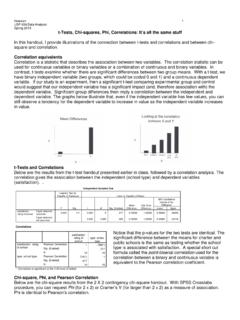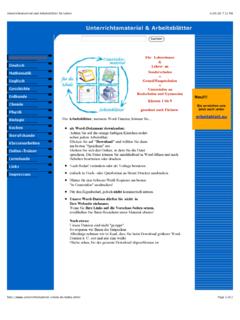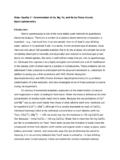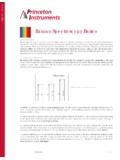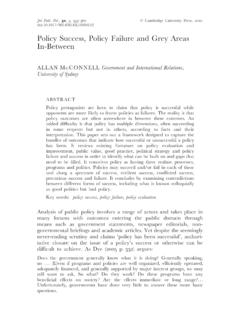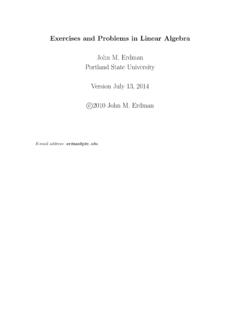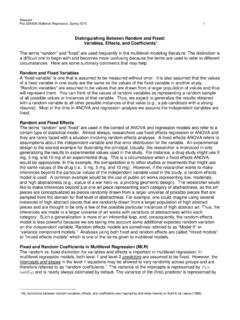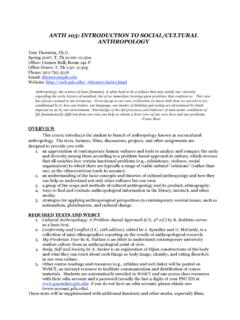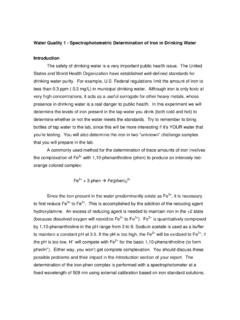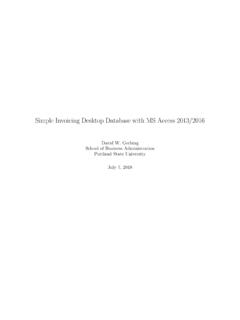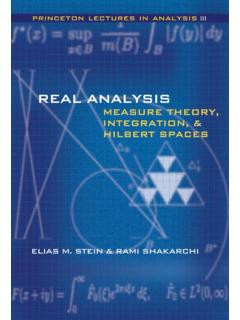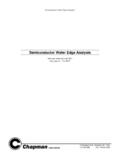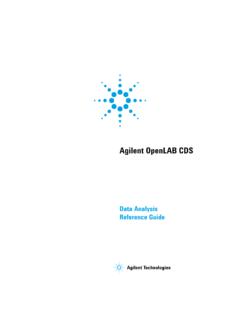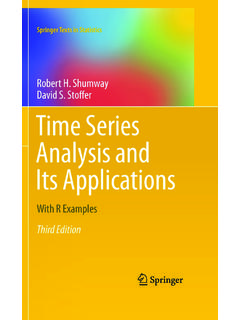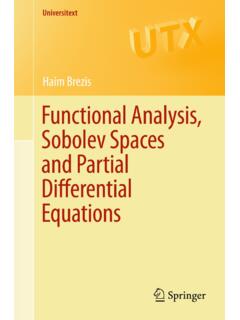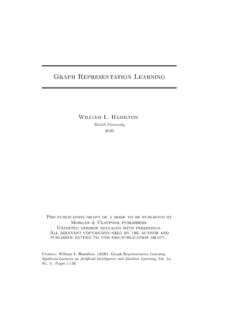Transcription of Functional Analysis and Operator Algebras: An Introduction
1 Functional ANALYSISANDOPERATOR Algebras: An IntroductionJohn M. ErdmanPortland State UniversityVersion October 4, 2015E-mail work is licensed under the Creative Commons Attribution-ShareAlike InternationalLicense. To view a copy of this license, visit is not essential for the value of an education that every idea be understood at thetime of its accession. Any person with a genuine intellectual interest and a wealthof intellectual content acquires much that he only gradually comes to understandfully in the light of its correlation with other related ideas.. Scholarship is aprogressive process, and it is the art of so connecting and recombining individualitems of learning by the force of one s whole character and experience that nothingis left in isolation, and each idea becomes a commentary on many NORBERT WIENERC ontentsPREFACEixGreek LettersxiFraktur FontsxiiNotation for Sets of NumbersxiiiNotation for FunctionsxivChapter 1.
2 LINEAR algebra AND THE SPECTRAL Vector Spaces and the Decomposition of Diagonalizable Normal Operators on an Inner Product Space8 Chapter 2. A VERY BRIEF DIGRESSION ON THE LANGUAGE OF Objects and Functors19 Chapter 3. NORMED LINEAR Bounded Linear Finite Dimensional Quotients of Normed Linear Products of Normed Linear Coproducts of Normed Linear The Hahn-Banach Theorems37 Chapter 4. HILBERT Definition and Unordered Hilbert space Orthonormal Sets and The Riesz-Fr echet Strong and Weak Topologies on Hilbert Universal Completion of an Inner Product Space54 Chapter 5. HILBERT SPACE Invertible Linear Maps and Operators and their Algebras with Self-Adjoint Normal Operators of Finite Rank66 Chapter 6. BANACH Natural Alaoglu s The Open Mapping The Closed Graph Banach Space Projections and Complemented The Principle of Uniform Boundedness85 Chapter 7.
3 COMPACT Definition and Elementary Partial Trace Class Hilbert-Schmidt Operators93 Chapter 8. SOME SPECTRAL The Spectra of Hilbert Space Operators99 Chapter 9. TOPOLOGICAL VECTOR Balanced Sets and Absorbing Compatible Locally Convex Spaces and Fr echet Spaces109 Chapter 10. Inductive Distributional Solutions to Ordinary Differential The Fourier Transform122 Chapter 11. THE GELFAND-NAIMARK Maximal Ideals inC(X) The Character The Gelfand UnitalC The Gelfand-Naimark Theorem132 Chapter 12. SURVIVAL WITHOUT Unitization of Banach Exact Sequences and Unitization ofC Positive Elements inC Approximate Identities145 Chapter 13. THE GELFAND-NAIMARK-SEGAL Positive Linear The GNS-Construction and the Third Gelfand-Naimark Theorem148 Chapter 14.
4 MULTIPLIER Hilbert Essential Compactifications and Unitizations156 Chapter 15. FREDHOLM The Fredholm The Fredholm Alternative Fredholm The Fredholm Alternative Concluded162 Chapter 16. Essentially Normal Toeplitz Addition of Completely Positive Maps172 Chapter 17. Equivalence Relations on A Semigroup of The Grothendieck TheK0-Group for UnitalC (A) the Nonunital Exactness and Stability Properties of Inductive Bratteli Diagrams189 Bibliography195 Index197 PREFACEPaul Halmos famously remarked in his beautifulHilbert Space Problem Book[24] that Theonly way to learn mathematics is to do mathematics. Halmos is certainly not alone in this current set of notes is an activity-oriented companion to the study of linear Functional analysisand Operator algebras. It is intended as a pedagogical companion for the beginner, an introductionto some of the main ideas in this area of Analysis , a compendium of problems I think are useful inlearning the subject, and an annotated reading/reference great majority of the results in beginning Functional Analysis are straightforward and canbe verified by the thoughtful student.
5 Indeed, that is the main point of these notes to convince thebeginner that the subject is accessible. In the material that follows there are numerous indicatorsthat suggest activity on the part of the reader: words such as proposition , example , exercise ,and corollary , if not followed by a proof or a reference to a proof, are invitations to verify theassertions made. Of course, there are a few theorems where, in my opinion, the time and effortwhich go into proving them is greater than the benefits derived. In such cases, when I have noimprovements to offer to the standard proofs, instead of repeating them I give material in these notes reflects the substance of portions of two year-long graduate coursescovering some elementary topics in(linear) Functional analysisandoperator algebras, which I taughtnumerous times at Portland State University. During these courses I asked students to choose, inaddition to these notes, other sources of information, either printed texts or online documents,which suited their individual learning styles (and budgets).
6 The prerequisites for working throughthese notes are quite modest; even the most casual Introduction tolinear algebra ,real Analysis ,andtopologyshould suffice. That is to say, terms such asvector space,linear map,limit,Lebesguemeasureandintegral,ope n set,compact set, andcontinuous functionshould sound Functional analysiscan be regarded, in some sense at least, as infinite dimensionallinear algebra , chapter one of these notes is devoted to a (rather condensed) review of some ofthe essential ideas that, in my fantasy world, students take away from their first course in linearalgebra. Three pivotal insights that are developed in the first chapter are:(a) a diagonalizable Operator on a finite dimensional vector space is a linear combination ofprojections;(b) an Operator on a finite dimensional inner product space is unitarily diagonalizable if andonly if it is normal; and(c) two normal operators on a finite dimensional inner product space are unitarily equivalentif and only if they have the same eigenvalues, each with the same regard these results as of fundamental importance because of the remarkable insights that haveflowed from the attempts made over the last century by Operator theorists to bring them intothe realm offunctional Analysis , that is, to generalize them to the infinite dimensional case.
7 Oneconsequence of this fertile and incredibly complicated exploration has been the discovery of manyastonishing, intimate, and complex relationships that exist betweenoperator theoryand such areasascomplex variables,algebraic topology, andhomological algebra . I attempt to retrace a few of thesesteps in later portions of these notes. The lectures on which these notes are based culminated inthe amazing results of Brown, Douglas, and Fillmore first published in 1973 (see [6]). Much of thebackground required for the development of this gorgeous material is, even now, difficult for mostgraduate students to find in a reasonably digestible form. Unfortunately, the business of transfiniteixxPREFACEarm-waving that works passably well in the lecture room translates very poorly indeed to paper orelectronic media. As a result, these notes are in a sadly unfinished state. I m working on them;and conceivably someone will finish what I do the material on linear algebra in the first chapter seems too condensed, a somewhat moreleisurely and thorough account can be found in my online notes [17].
8 Similarly, supplementarybackground material in advanced calculous, metric and topological spaces, Lebesgue integrals, andthe like, can be found in very many places, including [15] and [16].There are of course a number of advantages and disadvantages in consigning a document toelectronic life. One advantage is the rapidity with which links implement cross-references. Huntingabout in a book forlemma be time-consuming (especially when an author engages inthe entirely logical but utterly infuriating practice of numbering lemmas, propositions, theorems,corollaries, and so on, separately). A perhaps more substantial advantage is the ability to correcterrors, add missing bits, clarify opaque arguments, and remedy infelicities of style in a timelyfashion. The correlative disadvantage is that a reader returning to the web page after a short timemay find everything (pages, definitions, theorems, sections) numbered differently.
9 (LATEX is anamazing tool.) I will change the date on the title page to inform the reader of the date of the lastnontrivial update (that is, one that affects numbers or cross-references).The most serious disadvantage of electronic life is impermanence. In most cases when a webpage vanishes so, for all practical purposes, does the information it contains. For this reason (andthe fact that I want this material to be freely available to anyone who wants it) I am making use ofa Share Alike license fromCreative Commons. It is my hope that anyone who finds this materialuseful will correct what is wrong, add what is missing, and improve what is clumsy. I will includethe LATEX source files on my website so that using the document, or parts of it, does not involveendless retyping. Concerning the text itself, please send corrections, suggestions, complaints, andother comments to the author LETTERSxiGreek LettersUpper caseLower caseEnglish name (approximate pronunciation)A Alpha (AL-fuh)B Beta (BAY-tuh) Gamma (GAM-uh) Delta (DEL-tuh)E or Epsilon (EPP-suh-lon)Z Zeta (ZAY-tuh)H Eta (AY-tuh) Theta (THAY-tuh)I Iota (eye-OH-tuh)K Kappa (KAP-uh) Lambda (LAM-duh)M Mu (MYOO)N Nu (NOO) Xi (KSEE)OoOmicron (OHM-ih-kron) Pi (PIE)P Rho (ROH) Sigma (SIG-muh)T Tau (TAU)Y Upsilon (OOP-suh-lon) Phi (FEE or FAHY)X Chi (KHAY) Psi (PSEE or PSAHY) Omega (oh-MAY-guh)xiiPREFACEF raktur FontsIn these notes Fraktur fonts are used (most often for families of sets and families of operators).
10 Below are the Roman equivalents for each letter. When writing longhand or presenting materialon a blackboard it is usually best to substitute script English caseLower caseLower CaseAaaBbbCccDddEeeFffGggHhhIiiJjjKkkLll MmmNnnOooPppQqqRrrSssTttUuuVvvWwwXxxYyyZ zzNOTATION FOR SETS OF NUMBERS xiiiNotation for Sets of NumbersHere is a list of fairly standard notations for some sets of numbers which occur frequently inthese notes:Cis the set of complex numbersRis the set of real numbersRnis the set of alln-tuples (r1,r2,..,rn) of real numbersR+={x R:x 0},the positive real numbersQis the set of rational numbersQ+={x Q:x 0},the positive rational numbersZis the set of integersZ+={0,1,2,..},the positive integersN={1,2,3,..}, the set of natural numbersNn={1,2,3,..,n}the firstnnatural numbers[a,b] ={x R:a x b}[a,b) ={x R:a x < b}(a,b] ={x R:a < x b}(a,b) ={x R:a < x < b}[a, ) ={x R:a x}(a, ) ={x R:a < x}( ,b] ={x R:x b}( ,b) ={x R:x < b}D={(x,y) R2:x2+y2<1},the open unit discT=S1={(x,y) R2:x2+y2= 1},the unit circlexivPREFACEN otation for FunctionsFunctions are familiar from beginning calculus.
